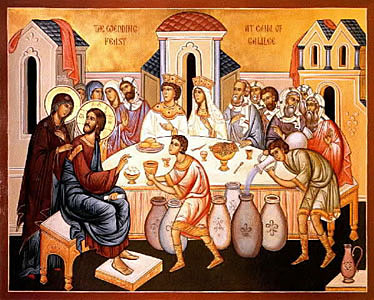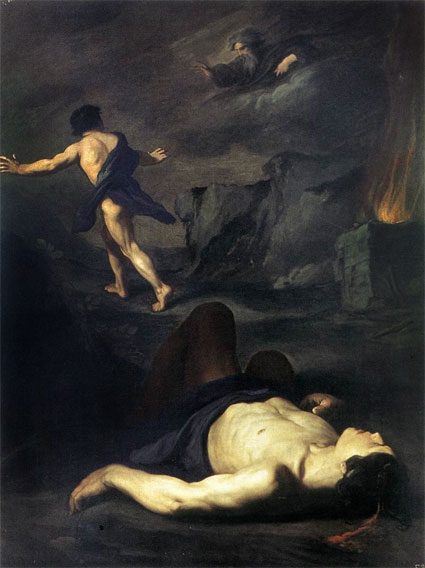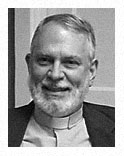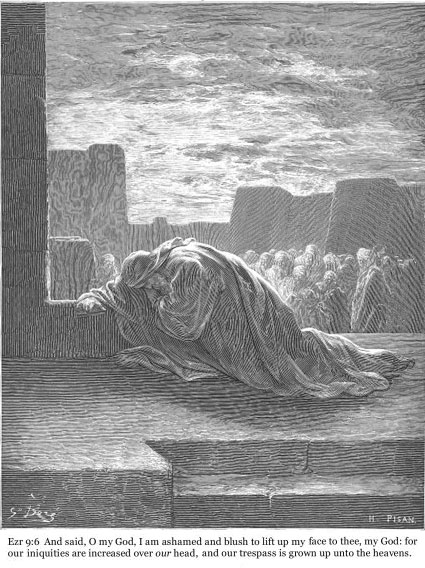Jun
8
2009
or Touch Not, Taste Not, Handle Not II

The dietary Laws given to Moses were an expansion of the command given to Adam. It is the self-denial of priestly obedience to God. Adam wasn’t ready for the tree of judicial responsibility (kingdom) but he seized it.
In the greater Bible picture, Israel’s history (from Moses) is this period of priestly obedience. But Jesus came and reversed Adam’s failure. Consequently the dietary laws are revoked, and with greater maturity, the people of God (through the first century death of Israel and her resurrection as the church) now, like Jesus, have the judicial wisdom of the Spirit, and the power to eat unclean things (Gentiles), consume them and make them clean. Only the power of resurrection can enter a room with a corpse in it, touch lepers and feast on Gentile meats and not be made unclean, but instead make the unclean clean by consuming it. This is the power of the New Covenant.
Continue reading
Comments Off | tags: Babylon, Crystal Sea, Daniel, Esther, Food laws, Postmillennialism, Priesthood, Resurrection, Scavengers, Tabernacle | posted in Biblical Theology
May
30
2009
A House of Bread
There are two kinds of whiteness in the Bible, and an understanding of this explains a great deal. There is the whiteness of covering and the whiteness of uncovering. And, as mentioned, the Bible makes a great deal out of the concept of covering.
Bone Collector
Purge me with hyssop, and I shall be clean; Wash me, and I shall be whiter than snow.
Touching a corpse made an Israelite unclean. The remains of those slain in battle were marked with lime for two reasons: so that they could be avoided by the clean, and so they could be gathered up and burned to lime by the bone collectors. Jesus said that the righteousness of the Pharisees was like a whitewashed sepulchre. Not only were they full of the ceremonial uncleanness of broken Covenant, their so-called righteousness was actually a mark from God upon them. They would be gathered to their people not by the Father sending His angels to the four corners of the Land, but by the father of lies and his scavengers sent by God to clean the wound.
This image goes right back to Genesis. Like the angels, the Covenant scavengers, though demonic, are also God’s servants. They are the raven of Noah surviving on floating corpses until the water goes down; they are the scavenging dogs that lick up Jezebel’s blood; they are the maggots in misused manna and abandoned grapes (false bread and wine); they are the unclean birds and animals that screech and howl inside the corpse of a defeated Babylon; they are worms inside Herod ‘enthroned’ as a human Gehenna.
The whiteness of the Pharisees was the whiteness of Miriam’s and Gehazi’s skin-plague. It is the whiteness of flesh and bones exposed as unclean to the eyes of God. Satan himself appeared as an angel of light, but like the Pharisees, he was a false lightbearer, a tutor guiding his children the wrong way.
Continue reading
Comments Off | tags: antichrist, Boaz, Egypt, Ezra, Herod, Jezebel, Lampstand, Laodicea, Leviticus, Manna, millstone, Pergamum, Pharaoh, Pharisees, Priesthood, Rahab, Resurrection, Revelation, Ruth, Samson, Scavengers, Solomon | posted in Biblical Theology, The Last Days, The Restoration Era
Apr
16
2009
This event would explain the massive discontinuity between the apostles and the church fathers. James Jordan writes:
The true Fathers of the Church are Noah, Abraham, Joseph, Moses, Jeremiah, Jesus, Paul, Peter, and John, and the other Fathers in the Bible. These men, under the guidance of the Holy Spirit, created the apostolic deposit from which the Church always grows. The men who came after them, in the first and second and third centuries, are not Church Fathers but Church Babies. We may think that because these men lived right after the apostles, they must have known a lot. Remarkably, this is not the case. Anyone who reads the Bible, climaxing in the New Testament, and then turns to the “apostolic fathers” of the second century, is amazed at how little these men seem to have known…
Continue reading
Comments Off | tags: AD70, Church Fathers, Church History, Firstfruits, James Jordan, Resurrection | posted in Against Hyperpreterism, Biblical Theology, The Last Days
Apr
16
2009

The Rest of the Dead
I saw the souls of those who had been beheaded for their witness to Jesus and for the word of God, who had not worshiped the beast or his image, and had not received [his] mark on their foreheads or on their hands. And they lived and reigned with Christ for a thousand years. But the rest of the dead did not live again until the thousand years were finished. This is the first resurrection. Revelation 20:4-5
James Jordan writes:
Continue reading
Comments Off | tags: Abel, AD70, Cain, James Jordan, Millennium, Resurrection, Revelation, Temple | posted in Against Hyperpreterism, Biblical Theology, The Last Days, Totus Christus
Apr
15
2009
Two Waters
Why is baptism for both males and females, when circumcision was only for males?
I have been following the Exodus pattern through the Bible, and an offshoot of that was an ‘accidental’ application to baptism. I’ll let you decide whether or not you think it holds water.
There are two ‘waters’ in the exodus pattern, the Red Sea (death) and the Jordan (resurrection).
Both are ‘baptisms’, but circumcision pertains to the Passover, the 2nd feast (unleavened bread). It is exit from the world and entry into a new people. There is blood and then water.
With Jordan, there is water, then blood – Jericho, the first conquest. This second baptism pertains to Atonement, the sixth feast. It is entry into, not a people, but an army. (The order of feasts comes from Lev. 23.)
Sabbath – God’s word through Moses (a single mediator for the people – Adam)
000PASSOVER – a baptism (death) that removes Adam’s sin. A ‘people’ assembled
000000FIRSTFRUITS – Moses ascends to receive the Law
000000000Pentecost – the Law given, the people tested
000000Trumpets – the ‘army’ is assembled and the Law repeated (Deut)
000Atonement - baptism (resurrection) and blood shed that removes ‘Eve’ from sin
BOOTHS – the army makes the Promised Land home (a corporate mediator for the nations – Eve).
Israelite males presented themselves before God at Passover/Unleavened Bread, Firstfruits and Booths. (Exodus 23:14-17) picturing the death, resurrection and marriage of the “bridegroom.” Trumpets summoned the people to prepare for Atonement, making ready the “bride.”
WEPOW
19 comments | tags: Atonement, Baptism, Circumcision, Feasts, Greater Eve, Mediator, Moses, Passover, Resurrection | posted in Biblical Theology
Apr
14
2009
or The Resurrection of Christ: Get Over It.
 The resurrection of Christ is the linchpin upon which all of Christianity depends. It is the point of the spear when it comes to evangelism.
The resurrection of Christ is the linchpin upon which all of Christianity depends. It is the point of the spear when it comes to evangelism.
But when the best theologians spend much of their time philosophising about its basic implications, their thinking divorced from most of the Bible, and relying instead upon Jewish fables and other ancient writings to form their opinions, we have a problem. When the cream of the crop are gagging on the milk, we have a problem.
Continue reading
Comments Off | tags: Hermeneutics, James Jordan, Paul, Resurrection, Typology, Uri Brito | posted in Biblical Theology
Apr
13
2009
Peter Leithart’s excellent 2009 Easter homily is here.
Comments Off | tags: Peter Leithart, Resurrection, Totus Christus | posted in Biblical Theology, Christian Life
Apr
10
2009
“For as often as you eat this bread and drink the cup, you proclaim the Lord’s death until He comes.”
If, as preterists maintain, Jesus came in AD70, why do you celebrate the Lord’s Supper?
To answer as an orthodox preterist (I’m sorry, but ‘partial’ doesn’t work for me), I would mention that the communion is a covenant memorial that reminds God of the covenant. The covenant is the key.
Continue reading
4 comments | tags: AD70, Communion, James Jordan, Peter Leithart, Resurrection, Revelation | posted in Against Hyperpreterism, Biblical Theology, The Last Days
Apr
10
2009

Ezra took a great risk to bring Levites and riches to the Temple from Persia. Mixed marriages were suddenly of more concern, which poses a difficult question. Things seem to be heading backwards—away from the New Testament rather than towards it.
Continue reading
Comments Off | tags: Ezra, Nehemiah, Peter Leithart, Pharisees, Priesthood, Resurrection, Tabernacle, Temple | posted in Biblical Theology, The Restoration Era
Apr
10
2009
Jesus As Yahweh
Veli-Matti Karkkainen points out that Philippians 2:9-11 alludes to Isaiah 45:22-23, where Yahweh declares Himself to be the one and only God, before whom “every knee will bow” and by whom “every tongue will swear.” Thus, “for Paul the resurrected and exalted Christ enjoys the same status as the God of Israel.”
Peter Leithart, www.leithart.com
Comments Off | tags: Isaiah, Paul, Peter Leithart, Resurrection | posted in Biblical Theology, Quotes





























